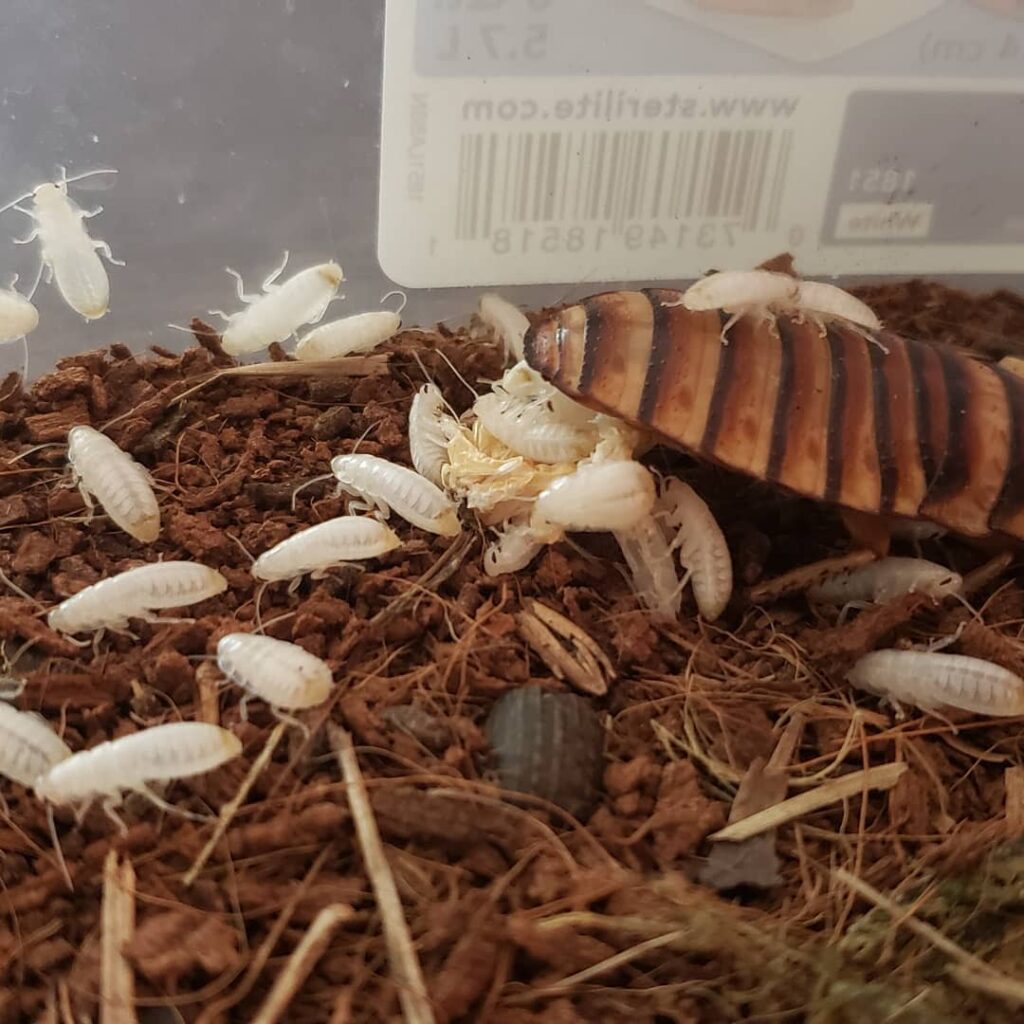When you hear the word “cockroach,” what comes to mind? For many people, it’s the image of a large, creepy-crawly insect scurrying across the floor.
But have you ever wondered what does a baby cockroach look like? It may seem like a trivial question, but understanding the appearance and behavior of these tiny creatures is crucial if you want to keep your home pest-free.
In this blog post, we’ll explore what baby cockroaches look like, why they’re important to identify, and what you can do to prevent a full-blown infestation.
So, if you’re ready to dive into the world of baby cockroaches, let’s get started!
What Does a Baby Cockroach Look Like

Baby cockroaches, also known as nymphs, are miniature versions of their adult counterparts. They are usually pale in color and have a soft, pliable exoskeleton that allows them to grow and develop rapidly.
Nymphs are typically smaller than adult cockroaches, ranging from a few millimeters to half an inch in length, depending on the species.
One of the most distinguishing features of baby cockroaches is their lack of wings. Unlike adult cockroaches, which have fully developed wings, baby cockroaches are wingless and have underdeveloped wing pads. This makes them more vulnerable to predators and limits their ability to travel long distances.
Baby cockroaches also have a distinct body shape. They are elongated and cylindrical, with a small head and long antennae. Their legs are relatively long and thin, allowing them to move quickly and easily through tight spaces.
As baby cockroaches mature, they shed their exoskeletons several times, growing larger and more developed with each molt.
With each molt, their exoskeleton hardens, and their wing pads become more pronounced until they eventually develop fully functional wings.
Related: How to get rid of roaches overnight
How Do You Know If You Have Baby Roaches?
If you suspect that you have a baby cockroach infestation, there are several signs to look out for:
1. Seeing live baby roaches
Baby cockroaches are small and can be difficult to spot, but they are still visible to the naked eye. Check areas where they may be hiding, such as under appliances, in cracks and crevices, and behind baseboards or cabinets.
2. Finding cockroach egg cases
Female roaches produce egg cases called oothecae, which can contain dozens of baby roaches. These egg cases are small, dark brown, and oval-shaped and can be found in dark, hidden places like cracks, crevices, and behind appliances.
3. Roach Droppings
Cockroach droppings are small, black or brown, and resemble ground coffee or pepper. You may find droppings in areas where cockroaches are present, such as in cabinets, drawers, or near food sources.
4. Unusual odors
Cockroaches emit a distinct, musty odor that can be noticeable in areas where they are present. If you detect an unusual smell in your home, it could be a sign of a cockroach infestation.
Where Do Baby Roaches Hide?
Baby cockroaches tend to hide in areas that provide them with warmth, moisture, and protection from predators.
Some common hiding spots for baby cockroaches include:
1. Cracks and crevices
Nymphs are small and can fit into tight spaces, so they often hide in cracks and crevices in walls, floors, and ceilings.
Also Read: How To Know If Roaches Are In Walls
2. Under appliances
Baby roaches are attracted to warmth and moisture, so they may hide behind or underneath appliances such as refrigerators, ovens, and dishwashers.
3. Cabinets and drawers
Cockroaches can hide in cabinets and drawers, especially those in the kitchen and bathroom.
4. Cluttered areas
Nymphs can hide in cluttered areas such as piles of clothes or papers.
5. Electrical outlets and switches
Young roaches can also hide behind electrical outlets and switches, as well as in wall voids.
How to Get Rid of Baby Roaches
Getting rid of baby cockroaches can be challenging, but there are several effective methods that can help:
1. Clean and declutter
Start by thoroughly cleaning your home and removing any clutter that may provide hiding places for baby cockroaches. Vacuum carpets and floors, wipe down surfaces, and dispose of any unnecessary items.
2. Seal entry points
Nymphs can enter your home through small cracks and crevices, so it’s important to seal these entry points with caulk or sealant.
3. Use baits
Cockroach baits are a popular and effective way to eliminate nymphs. Baits contain a slow-acting poison that cockroaches eat and then carry back to their nest, eventually eliminating the entire colony.
4. Apply insecticides
There are many insecticides available that are effective at killing baby cockroaches. These can be in the form of sprays, baits, or powders. Be sure to follow the manufacturer’s instructions carefully.
Also Read: How to Get Rid of Cockroaches Using Diatomaceous Earth
5. Call a professional
If you have a severe or persistent infestation, it may be necessary to call a pest control professional. They can assess the extent of the infestation and develop a treatment plan that is tailored to your specific needs.
Prevent Future Infestations
Once you have eliminated the baby cockroach infestation, it’s important to take steps to prevent it from happening again. This can include keeping your home clean and dry, storing food in airtight containers, and sealing cracks and crevices.
Bugs That Look Like Baby Roaches
There are several types of insects that can be mistaken for baby cockroaches due to their similar appearance.
Here are some examples:
1. Carpet beetles
Carpet beetles are small, oval-shaped insects that have a similar size and shape to baby cockroaches. They are typically brown or black in color and have short antennae.
2. Booklice
Booklice are tiny insects that are often found in humid areas of the home such as basements, bathrooms, and kitchens. They are pale brown in color and have a similar size and shape to baby German cockroaches.
3. Crickets
Young crickets can sometimes be mistaken for baby cockroaches due to their similar size and shape. However, crickets are typically lighter in color and have longer antennae than cockroaches.
4. Bed bugs
Although bed bugs are not similar in appearance to baby cockroaches, they can be mistaken for them due to their small size and ability to hide in cracks and crevices.
FAQs
Do baby roaches mean infestation?
Yes, the presence of baby cockroaches can indicate an infestation. Nymphs are typically born in large numbers, so if you see one or two, it’s likely that there are many more hiding in your home.
Additionally, baby cockroaches need a source of food and water to survive, so their presence can indicate that there is a larger cockroach population in your home.
Can baby roaches be eliminated without professional help?
In some cases, it may be possible to eliminate a baby cockroach infestation without professional help.
However, it can be challenging to find and eliminate all of the hiding places where nymphs may be located, so it’s often best to contact a pest control professional who has the knowledge and tools needed to effectively eliminate the infestation.
Are baby cockroaches dangerous?
While baby cockroaches themselves are not typically dangerous, they can be a sign of a larger cockroach population that can pose health risks.
Cockroaches can spread bacteria, contaminate food, and trigger asthma and allergy symptoms in some people. It’s important to eliminate baby cockroach infestations as soon as possible to reduce these risks.
Conclusion
Being able to identify baby cockroaches is an important step in preventing and eliminating cockroach infestations in your home.
By understanding what baby cockroaches look like and where they like to hide, you can take proactive steps to keep your home clean and prevent cockroaches from taking hold.
Remember, if you do find baby cockroaches in your home, it’s important to take action quickly to eliminate the infestation and prevent it from spreading. With the right methods and persistence, it is possible to keep your home free of baby cockroaches and other pests.

I’m Mike Hyle, an exterminator with 7+ years of experience handling all sorts of pests, including mice, cockroaches, bed bugs, and termites. I also write for Pest Solutions DIY blog to share my knowledge and help homeowners keep their homes pest-free. Outside work, I enjoy hunting, snowshoeing, and exploring nature. Check out my blog for helpful pest control tips!
